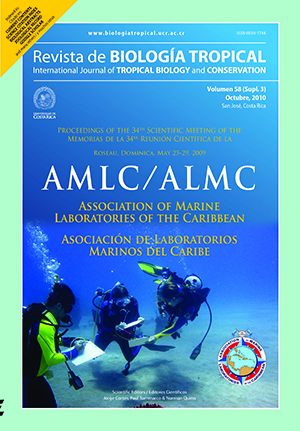Abstract
Mangrove roots are important habitats for many species. The abundance and richness of mollusks and crustaceans associated with the roots demerged of Rhizophora mangle was studied. The samples were gathered between February 2005 and January 2006, in Bocaripo lagoon, north coast of Sucre state, Venezuela. Five stations were established inside the lagoon; on every station two roots were chosen at random, put in plastic bags and scraped. The associated organisms were separated by taxa and fixed in 10% formaldehyde. One thousand ninety two specimens of mollusks, distributed in two classes: Bivalve and Gastropod were collected. Bivalve was the most abundant with 943 individuals. The most representative family was Mytilidae with 6 species, being Musculus lateralis the dominant species. The crustaceans were represented by 372 organisms, belonging to the class Malacostraca, where Panopeus herbstii (169 ind.) was the most abundant species. The families Panopeidae, Porcellanidae and Majidae had the highest number of species. Maximum abundance was in February (224 ind.), with a richness of 25 species and the minimums in November (45 ind.) and a richness of 12 species. The stations 1 and 5 presented the major abundance and richness of organisms, which could be related to environmental conditions favorable, as the major availability of microhabitats and nourishing offer; on the contrary the station 4, presented a more inhospitable environment, due to the high values in the salinity and temperature, which contributes with the minor abundance and richness of the present species.##plugins.facebook.comentarios##

This work is licensed under a Creative Commons Attribution 4.0 International License.
Copyright (c) 2010 Revista de Biología Tropical
Downloads
Download data is not yet available.






